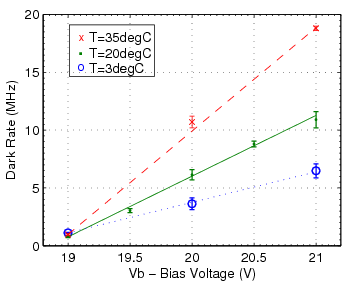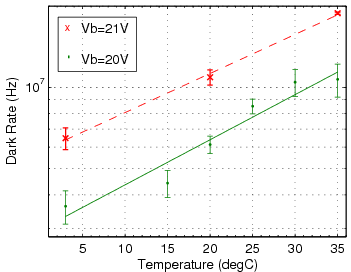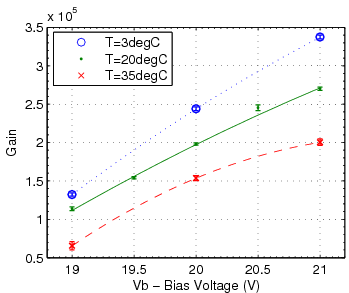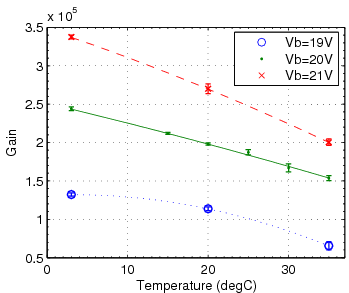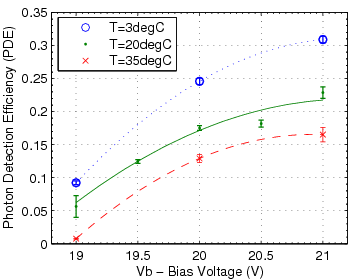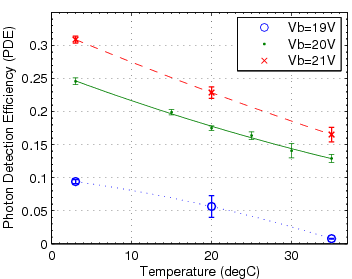Difference between revisions of "Characterizing SiPMs"
Senderovich (talk | contribs) |
Senderovich (talk | contribs) m |
||
| Line 26: | Line 26: | ||
== SiPM Measurements == | == SiPM Measurements == | ||
| − | {| class="wikitable" style="text-align:center" border="1" cellpadding=" | + | {| class="wikitable" style="text-align:center" border="1" cellspacing="0" cellpadding="5" |
| − | |+ Summary of SiPM Properties measured at room temperature at | + | |+ Summary of SiPM Properties measured at room temperature at recommended bias voltages |
|- | |- | ||
!rowspan="2"| Device | !rowspan="2"| Device | ||
Revision as of 18:05, 10 August 2007
SiPM Performance Requirements
The tagger microscope consists of many identical and well isolated readout channels, each consisting of a several cm long scintillating fiber connected to a clear acrylic fiber light guide. A tagging electron travels axially down the length of a scintillating fiber depositing 4 MeV of energy in the fiber, resulting in 1600 scintillation photons within the forward capture cone of the fiber. Assuming that 80% of these are delivered to the SiPM active surface and a conservative estimate of 15% for the efficiency of the SiPM leads to an estimate of 190 for the average SiPM pixel count per event. Monte Carlo simulations have shown that an efficient detection threshold corresponds to 40% of the average pulse height, or 80 SiPM pixels. This implies a requirement for the dark rate that spontaneous pulses never exceed 80 pixels.
The large photon yield expected at the end of the light guide does not demand unusual detection efficiency on the part of the SiPM. For example, 10% efficiency with the above number of photons still yields a signal of 130 photons. However, given that the scintillator (BCF-20) has a finite decay time (2.7ns) the more photons are produced the more clearly resolved is the time of the pulse.
The device is expected to have a high enough gain (measured in electrons per photon detected) - around 106. in order for such a small light signal to be recorded by conventional electronics. Such devices are also susceptible to spurious, thermally excited pixel breakdowns, each showing up as a single photon hit ("dark count"). High rate of these single-pixel events may create a pileup above the signal threshold. All of the above parameters (detection efficiency, gain and "dark rate") depend on applied bias voltage and temperature. Stability of performance despite expected fluctuations of these variables is an important requirement.
Another criterion in SiPM selection is its dynamic range. Although this readout device essentially provides digital output - scintillation detected or not - enough of a range is necessary to set a threshold above the noise floor and to account for some pixels being not having required from a previous hit .
SiPM Measurements
| Device | Gain | PDE (yellow) | Dark Rate | |||
|---|---|---|---|---|---|---|
| Nom. | Meas. | Nom. | Meas. | Nom. | Meas. | |
| SSPM-050701GR-TO18 [1] | 0.8×106 | 1.1×106 | ~29% | ~30% | 10 MHz | 9.8 MHz |
| SSPM-0606BG4-PCB [2] | 1.5×105 | 2.5×105 | 27% | 20-23% | 15 MHz | 8.9 MHz |
Links
Written and last edited by Igor Senderovich 23:47, 8 August 2007 (EDT)
